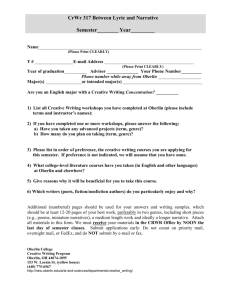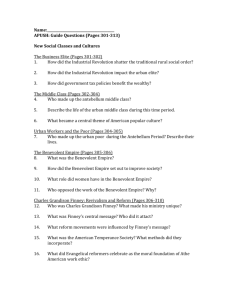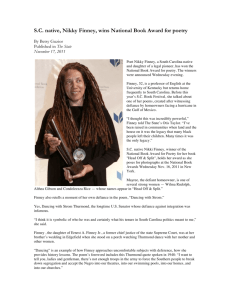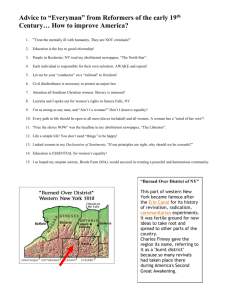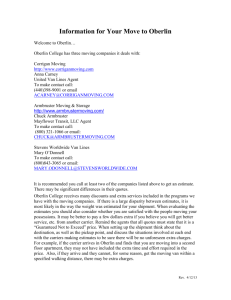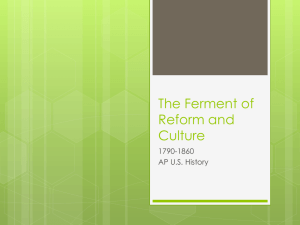Charles Grandison Finney
advertisement
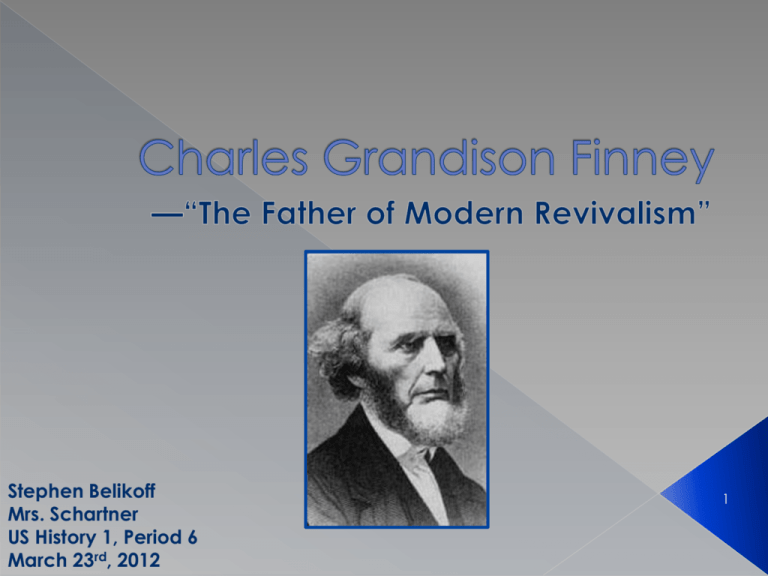
Stephen Belikoff Mrs. Schartner US History 1, Period 6 March 23rd, 2012 1 Philosophy/Beliefs, Policy, and Physical/Mental Characteristics Brief Biography on the life of Finney General Information on the movement(s) Finney was involved in › 2nd Great Awakening Revivalism Finney’s Contributions to his movement and preaching style Effects of Finney’s Contributions Bibliography/Citation Page 2 3 “Human nature is not intrinsically sinful” › Human beings have the ability to choose for the greater good when they want to, humans are NOT inherently wrong doers Believed Christ died for the salvation of all those who accepted him and that those who did not are to suffer damnation which he feels is eternal separation from God Anti-Calvinist Anti-Slavery Pro Women’s and African American rights 4 Utilized advertising to generate interest Everyone, even women, is allowed to pray in public Multi church participation Used psychological techniques to trigger responses to people on a personal effort in order to revive their faith › Preached like a lawyer from a pulpit- outlining his argument as if her were speaking to a jury, using logic, persuasion, and playing on emotions like hope and fear 5 As an adult he: › › › › Stood six feet two inches tall Had “piercing” blue eyes Musically inclined Distinct leadership qualities which landed him a good spot in the community Loud, firm, and charismatic voice › Largely self educated › Hard worker 6 7 Born August 29th, 1792 in Warren, Connecticut › Parents were non believers, Grandison was not brought up at first to be religious 1794: Moved to Oneida County in Central New York › Later relocated a few years later to the New York shore of Lake Ontario Educated at an Uncle of his’ academy back in Connecticut › Never attended college, but learned some Latin, Greek, and Hebrew from a Presbyterian minister named George Gale in western New York 1818: Went to study as an apprentice under Benjamin Wright to be a lawyer 1820: Admitted to state bar 1822: Underwent a religious conversion after a religious epiphany and began a period of religious study under Reverend George Gale 8 1822: Began ministerial career › First year of Evangelism spent in Jefferson and St. Lawrence counties (New York) 1823: Became a candidate for the ministry at St. Lawrence Presbytery › 1824: Ordained minister October 1824: Married Lydia Andrews (first of three wives and the only one he had children with) 1825: Work in Rome and Utica, New York › Brought about dramatic conversions amongst slightly interested Christians and skeptics Utica: Converted one Timothy Weld, who would later go on to be a prominent Abolitionist 9 1830: He was preaching in New York City and Boston › Wealthy Christian laymen (men religious, but not part of the clergy) began to support Finney Most Prominent Supporters: Tappan Brothers (future founders of Oberlin College and prominent abolitionists) Arthur Tappan Lewis Tappan Arthur Tappan Lewis Tappan 10 1836: Founded and pastored the Broadway Tabernacle (Broadway United Church of Christ) › Finney designed the building and it was built for him › Formed as a Congressionalist church, though Finney had before been a Presbyterian Finney had become increasingly dissatisfied with conservative Presbyterian theology and discipline, so he left the Presbyterian Church and took on Congregationalism for it was more flexible in embracing Finney’s beliefs Broadway Tabernacle 11 September 2, 1833: Inspired by Finney, the Tappan brothers provided the financial means to found Oberlin College in Ohio for evangelical education in a social setting reflecting Finney’s reforms 1835: Moved to Oberlin to become a theology professor at Oberlin College 1851: Became President of Oberlin College 1837-1872: Served as pastor of the First Congregational Church in Oberlin, after leaving the Broadway Tabernacle Oberlin College: Oberlin College was the first college that allowed blacks and women in the same classrooms as white men as well as at the same lunch table 12 1866: Wrote his Memoirs in response to published autobiographies of two of his main opponents in a vain attempt to change their views › Focused mainly on the revivals › Opponents: Lyman Beecher Asahel Nettleton 1875: Maintained his career as a preacher, teacher, and writer to the end of his life August 16th, 1875: Died at his home in Oberlin of heart failure at the age of 82 13 14 Went on from the late 1820s to the late 1830s An “awakening” or renewal of religious awareness and faith throughout America that restored American faith back to the way it had been Appealed to: African Americans, women, and industrialists looking to discipline their workers 15 Came from the Second Great Awakening movement Involved renewing the belief in God within individuals who have lost their way over time More material ways of attracting churchgoers were accepted, such as advertising and logical lectures Charles G. Finney was the most prominent as his lectures spurted up members of the church significantly 16 17 Contribution Effect Preaching in New York and Boston Converted many of those who had lost faith in their religion. Also brought together abolitionists and inspired some to join the anti-slavery movement. Inspired the Tappan brothers to found Oberlin College, which reflects the beliefs of Finney. Inspiring Oberlin College First College to ever school blacks and women with white men in the same classroom as well as eating at the same table. Created a place where the abolitionism movement could start being cultivated. The College also played an important role in facilitating the underground railroad. Innovative Preaching Style Greatly increased the amount of revivals there were. Increased his amount of followers he had, which in term increased the amount of people following Finney’s philosophy. Thus more and more people began to support women’s rights, abolitionism, black rights, etc. Revivals Emergence of the mercantile and manufacturing economy instead of an agricultural economy as his revivals provided religious justification for a freelabor, wage based work force. 18 "Charles Grandison Finney." American History. ABC-CLIO, 2012. Web. 9 Mar. 2012. Scott, Donald. "Evangelism, Revivalism, and the Second Great Awakening." nationalhumanitiescenter.org. National Humanities Center, dd 010 2000. Web. 22 Mar 2012. <http://nationalhumanitiescenter.org/tserve/nineteen/nkeyinfo/nevanrev.htm>. Buttre John Chester. Lewis Tappan. 1870. Engraving. Collection New-York Historical Society, London. Print. Name, Unknown. "Finney, Charles Grandison." www,newworldencyclopedia.org. New World Encyclopedia, 02 010 2011. Web. 22 Mar 2012. <http://www.newworldencyclopedia.org/entry/Charles_Grandison_Finney>. Unknown Artist. Arthur Tappan. 1870. Engraving. Collection New-York Historical Society, London. Print. Artist Unknown. Oberlin College circa 1835. 1835. Drawing. http://spydersden.files.wordpress.com, Oberlin, Ohio. Web. 22 Mar 2012. <http://spydersden.files.wordpress.com/2012/02/oberlin.jpg>. Unknown Artist. Broadway Tabernacle Church, New York, N.Y.. 1900-1910. Photograph. Detroit Publishing Company Photograph Collection, Detroit. Web. 22 Mar 2012. <http://www.encore-editions.com/broadway-tabernacle-church-new-york-n-y>. Foner, Eric, and John A. Garraty. "Second Great Awakening." The Reader's Companion to American History. Dec. 1 1991: n.p. SIRS Issues Researcher. Web. 23 Mar 2012. 19

